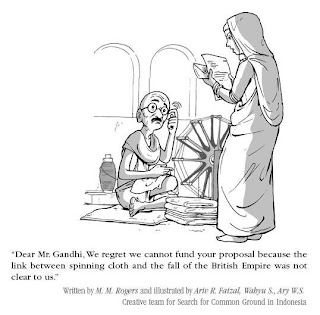Where do Interventions Come From?

By LEAD Research Team
I came across a reference to a paper that was written in the 1800s (in Dublin), where the researcher attempted to help the poor in his neighborhood by employing them in spinning linen-yarn. He reflects on some of the limitations of his endeavor:
“Another observation and a most important one is this: that we are not to be immediately discouraged by the failure of an attempt to relieve the poor, nor to pronounce at once that the scheme is injudicious or inefficient. It may have failed from some mismanagement in the execution; and if that were corrected, might succeed perfectly”
It was a little strange to be nodding along to an account written over 200 years ago, but it did echo some familiar concerns. First of all, can the success of an intervention really be this random? –where had a different ‘intervener’” been chosen, the results could be drastically different even if the intervention remained the same?
In intervention studies, not much discussion is devoted to the actual process of implementing the intervention— how the idea was developed and executed. Was it conceived in a vacuum or based on a pattern of observations? Was there a good understanding of the history of the intervention tried in the past? To this second point, it’s admittedly difficult to build on previous interventions because studies don’t lend themselves easily to comparisons—each study works with different demographics, measures different outcomes, and through different execution methodologies that can go unobserved or undocumented.
What is interesting about older (much older) literature is that it has a rich documentation of observations that give insights into both the intervention and the intervener. They read like diaries. There is a documentation of the thought process and the evolution of ideas
In today’s context, there is real value in documenting this process of developing and delivering an intervention. First, it can force researchers or practitioners to justify the logic in pursuing a particular idea, so ideas are not tested out of context and there is some accountability.
Second, it can lead to a better interpretation of the results of the study by providing a way back to reflect on the process and decide where to attribute failure. Discussions on the complexity of the intervention, limitations in its execution, and the corresponding changes made in design and delivery allow for a more realistic interpretation of study results– and as the author in the beginning warns, to not dismiss an effort without understanding all the delivery-associated factors that may have contributed to disappointing results.
Finally, the long-term value of such documentation is that future studies can draw on a body of collective insight to develop better interventions. This is important because ultimately innovative and impactful interventions come from observation and new insights. For example, at my previous job, we found it a little odd that some of our farmer clients who, upon receiving their harvest income, would cycle 45 minutes out of their way, by-passing their family and friends’ homes, to ask us to hold their money in our cashbox for 4 full months until they needed it for fertilizer. A year later, I was interested to see similar observations made in an IPA study that designed an intervention to offer vouchers that committed farmers to purchasing fertilizer immediately after harvest (when farmers had cash),–the result of the study being that it significantly increased investment in and usage of fertilizer.
Documenting and drawing from these insights is also a way to learn from peers and past experiences. It’s surprising that although the landscape of financial inclusion has changed significantly, we are still struggling with some of the same questions. Some of the rhetoric used 200 years ago is strangely familiar to that of today. For example, see herefor an account written in the year 1805 about challenges in savings practices of the poor and compare it current discussions on savings barriers. It makes me question how far we’ve really come in understanding motivations and behaviour and to what extent current interventions accurately reflect this understanding.





